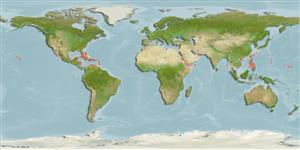Common names from other countries
Environment: milieu / climate zone / depth range / distribution range
Ecologia
; Água doce; intervalo de profundidade 0 - 1 m (Ref. 83435). Tropical; 32°N - 9°N, 90°E - 60°E (Ref. 83435)
Indo-Pacific and Western Central Atlantic.
Length at first maturity / Tamanho / Peso / Idade
Maturity: Lm ? range ? - ? cm Max length : 3.5 cm SHL macho/indeterminado; (Ref. 349); common length : 2.5 cm SHL macho/indeterminado; (Ref. 349)
Used as food by coastal populations of oceanic islands in the West Pacific (Ref. 349). Very common in the upper part of shores, often in crevices and pits of rock benches, or on branches of littoral trees overhanging the water. Moves up and down the shore in correlation with the prevailing high water level of the tide and can withstand heat and desiccation for long periods (Ref. 349). Nocturnal. Grazes on surface film of very fine marl particles, detritus, algae, flagellates, diatoms and nematodes (Ref. 96894).
Life cycle and mating behavior
Maturidade | Reprodução | Desova | Ovos | Fecundidade | Larvas
Members of the order Neritopsina are mostly gonochoric and broadcast spawners. Life cycle: Embryos develop into planktonic trocophore larvae and later into juvenile veligers before becoming fully grown adults.
Poutiers, J.M. 1998. (Ref. 349)
Categoria na Lista Vermelha da IUCN (Ref. 130435)
Categoria CITES (Ref. 108899)
Not Evaluated
Not Evaluated
Utilização humana
Pescarias: espécies comerciais
| FishSource | Sea Around Us
Ferramentas
Mais informação
Idade/TamanhoCrescimentoComprimento-pesoComprimento-comprimentoMorfologiaLarvasAbundância
Fontes da internet
Estimates based on models
Preferred temperature
(Ref.
115969): 25.2 - 28.9, mean 27.7 (based on 945 cells).
Vulnerabilidade
Low vulnerability (10 of 100).
Categoria de preço
Unknown.
